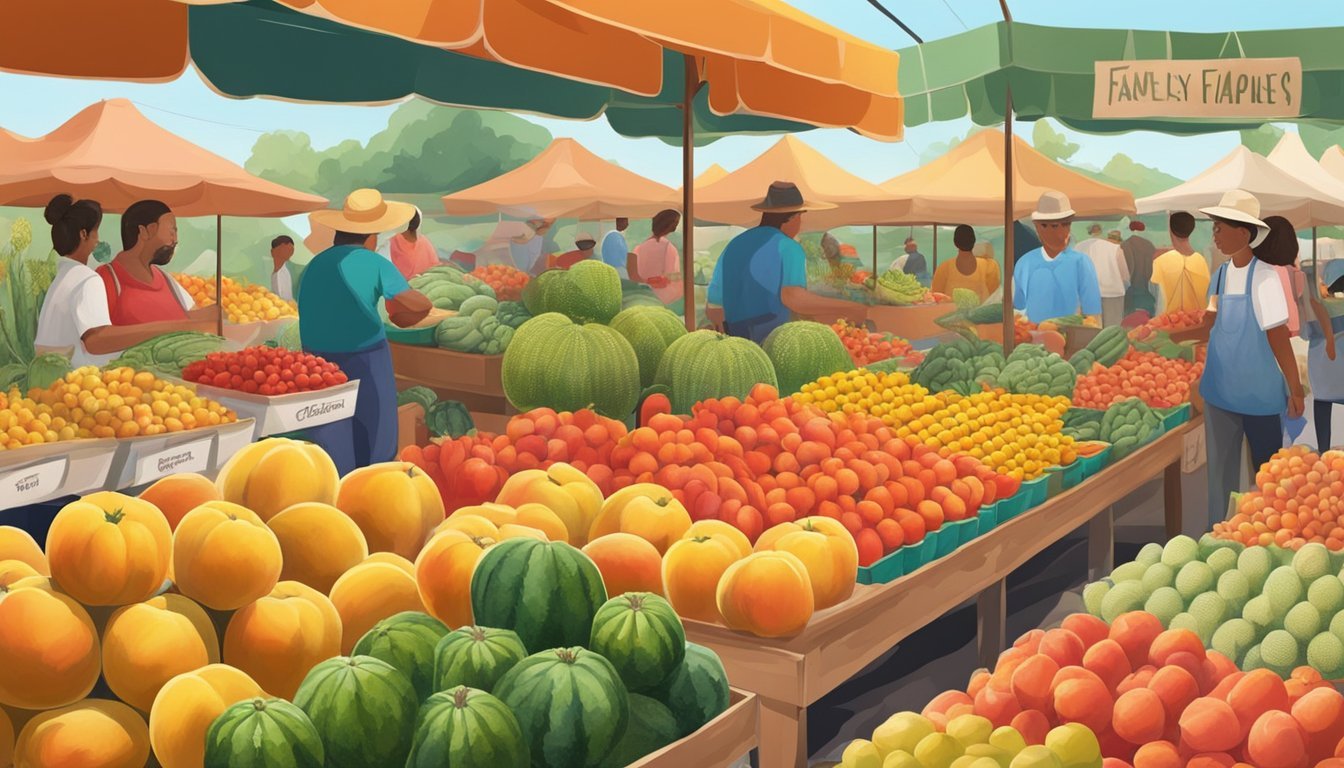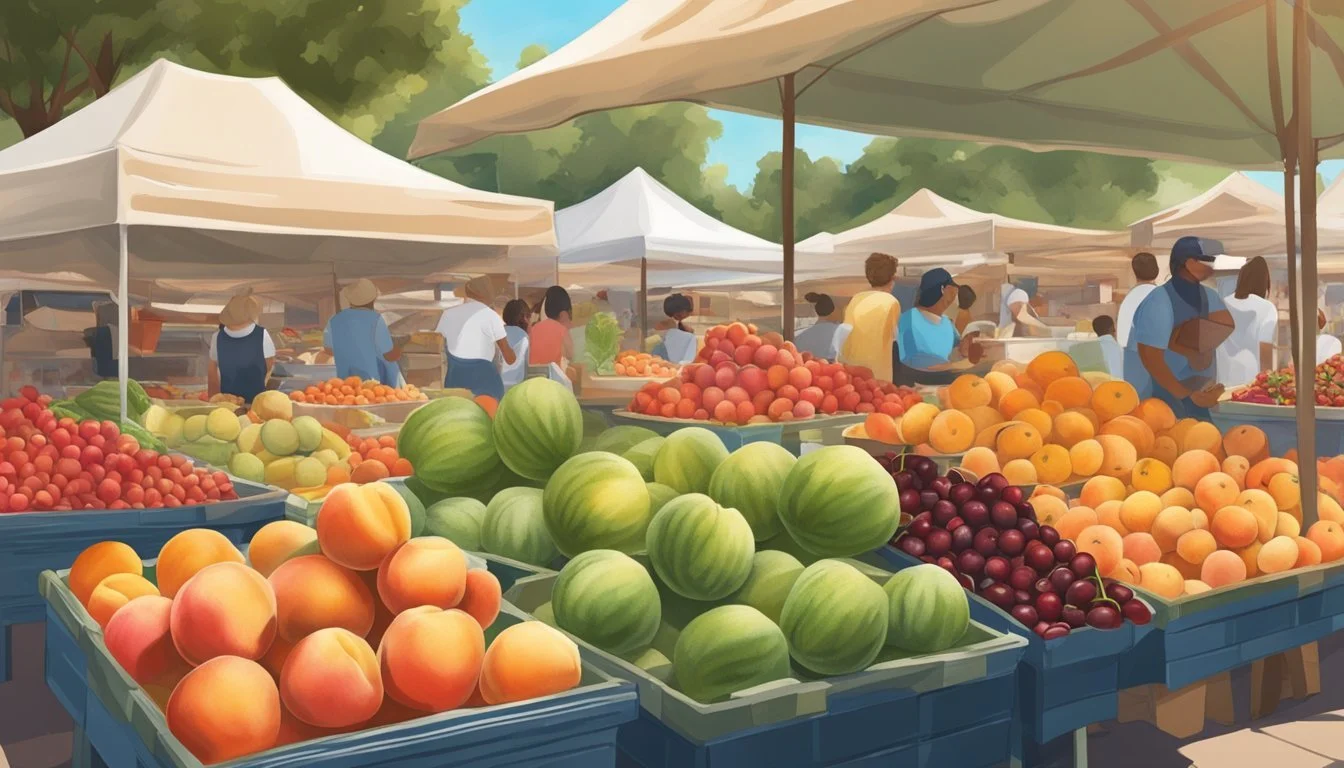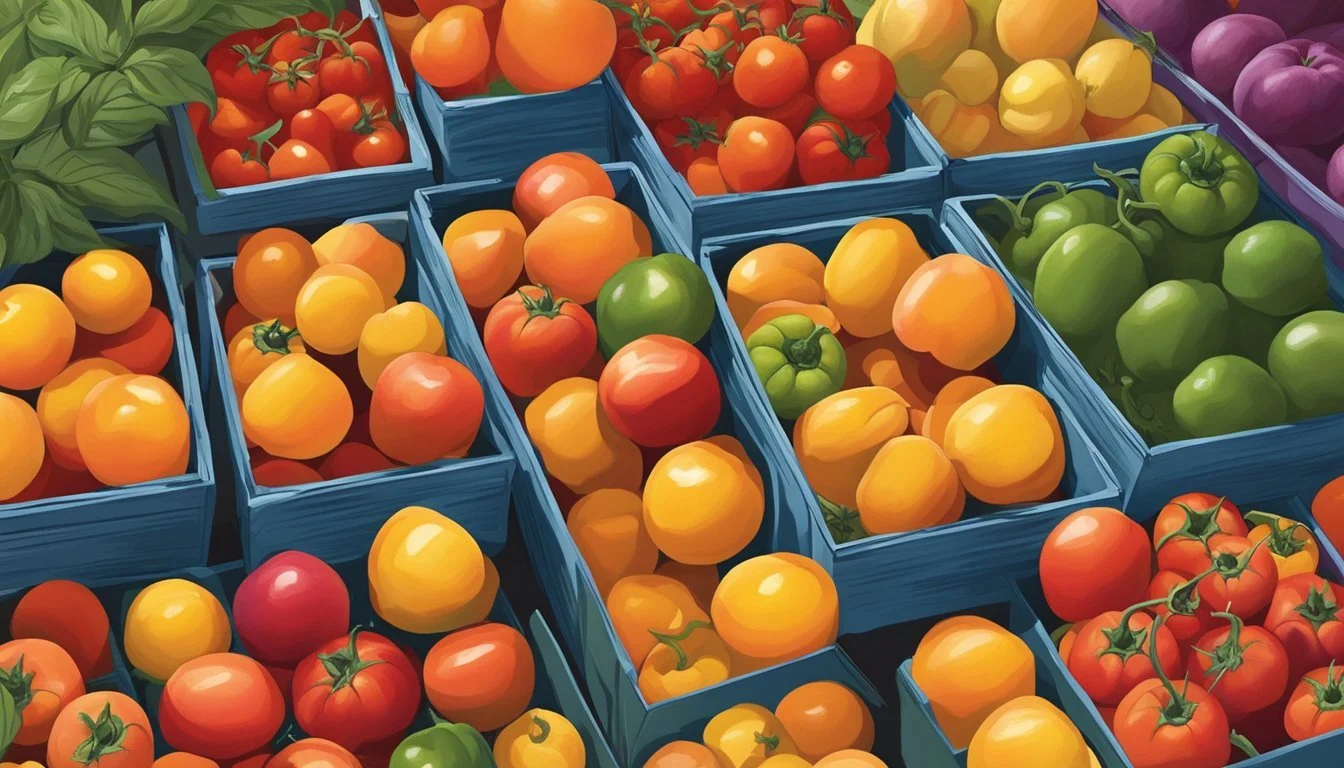Arizona Seasonal Fruit & Vegetables in July
Your Guide to Fresh Produce
This Article is Part of our Arizona Seasonal Fruit & Veg Calendar
In Arizona, the month of July marks a time of transition in the agricultural calendar, where the warm, dry climate significantly influences the variety of produce available. The state's distinct regions, each with varying altitudes and microclimates, contribute to the diverse range of fruits and vegetables that ripen under the relentless summer sun. July's harvest embodies the robust flavors and vibrant colors of summer produce, providing an array of options for residents and visitors alike.
The selection of fruits in July is particularly rich with varieties that thrive in the heat. Local markets and farms teem with black-eyed peas (how long do black-eyed peas last?) and the tail end of blackberry season, allowing for fresh, locally-sourced ingredients for both sweet and savory dishes. As the temperatures soar, these crops reach their peak, ensuring that the fruit is at its most flavorful when it makes its way to consumers.
For vegetables, the month of July offers a bountiful harvest as well. The persisting heat accelerates the growth of certain vegetables, making them abundant during this period. Farmers work diligently to supply a steady stream of produce that can withstand the harsher growing conditions, ensuring that even amidst the peak of summer, there is no shortage of fresh vegetables to be enjoyed throughout the state.
Benefits of Eating Seasonally
Eating seasonally, especially in Arizona during July, offers a myriad of benefits. Individuals can improve their health by consuming a diversity of fruits and vegetables that are at their peak nutrition and flavor in the summer.
Nutritional Value
Seasonal produce in the summer months is often fresher and, as a result, packed with optimal nutrition.
Fruits: Watermelon, peaches, apricots
Vegetables: Corn (how long does corn last?), cucumbers (how long do cucumbers last?), tomatoes
These fruits and vegetables provide essential vitamins and antioxidants that support a healthy immune system.
Environmental Impact
Choosing seasonal produce helps reduce the ecological footprint.
Less transportation required for local produce
Decreased greenhouse gas emissions
During the summer season, local farmers markets can be a source for these seasonal items, cutting down on the environmental costs usually associated with shipping foods over long distances.
Economic Benefits
When consumers buy seasonal produce, they support local farmers and the local economy, which can lead to better prices and more sustainable farming practices. Seasonal fruits and vegetables tend to be more affordable when they are abundant.
Taste and Enjoyment
Summer fruits and vegetables harvested at the right time are known for their superior taste and texture. This enhances the overall eating experience, leading people to often prefer the flavor of seasonal options over out-of-season imports.
In conclusion, incorporating seasonal produce into the diet during the summer in Arizona enriches the palette, bolsters health, supports the local economy, and reduces the impact on the environment.
Seasonal Fruits in July
In Arizona, July signals the peak availability of an array of juicy and flavorful fruits. This period is especially rewarding for berry and stone fruit aficionados.
Berries
Blackberries: Peak season for blackberries, they are at their juiciest.
Blueberries: (how long do blueberries last?) Towards the end of their season, but still available fresh.
Stone Fruits
Nectarines: They are in full swing, ripe and ready for consumption.
Peaches: Juicy and plentiful, peaches are a highlight of the month.
Melons
Cantaloupes (how long does cantaloupe last?): Beginning to come into season, offering a sweet, hydrating option.
Watermelons: Also just starting, perfect for the hot Arizona summer.
Miscellaneous Fruits
Figs: Fresh figs start to appear in markets this time of year.
Tomatoes: Although often grouped with vegetables, they are a fruit and in prime season.
Seasonal Vegetables in July
In July, Arizona's local produce markets display a variety of fresh vegetables thriving in the summer heat. Shoppers can find an assortment of root vegetables, leafy greens, summer squash, and other miscellaneous vegetables.
Root Vegetables
Beets (how long do beets last?): They reach their peak this month and are perfect for cold salads.
Corn: Sweet corn is abundant, making it ideal for barbecues and roasts.
Leafy Greens
Leafy greens tend to struggle with the intense heat of July, but certain varieties still perform well:
Arugula: Slightly spicy, it's great in salads and available until the end of the month.
Summer Squash
Squash varieties flourish in the warm climate:
Yellow Squash: Tender and versatile, it's a summer staple in many dishes.
Zucchini: These are at their best in July, ready for grilling or adding to stir-fries.
Miscellaneous Vegetables
Cucumbers: Crisp and refreshing, they are perfect for salads and pickling.
These vegetables are just a snapshot of what Arizona has to offer in July, each bringing fresh flavors perfect for the season.
Storing and Preparing Seasonal Produce
When handling seasonal fruits and vegetables in July, one must consider the best methods of storage and preparation to maintain their freshness and nutritional value.
Storage:
Fruit: Most summer fruits such as peaches, plums, and melons should be stored at room temperature until ripe. Once ripened, they can be refrigerated to extend their freshness. Berries should be kept in the refrigerator and washed just before eating or using.
Vegetables: Leafy greens must be stored in the crisper drawer of the refrigerator to maintain their crispness. Root vegetables like carrots and onions last longer in a cool, dry place, and should not be refrigerated.
Preparation:
Produce Washing: All produce should be washed thoroughly under cold running water, even if one plans to peel it.
For vegetables like zucchini that will be cooked, one may opt to peel and cut them ahead of time for convenience. However, exposure to air can degrade nutrients, so it’s best to cut close to cooking time.
Fruit like berries are delicate and should not be soaked. Rinse them gently just before consumption or use in recipes.
When preparing produce, consider methods that retain nutritional quality. For example, steaming vegetables instead of boiling can preserve vitamins and minerals.
In summary, proper storage and preparation can greatly influence the taste and nutritional benefits of Arizona's seasonal fruits and vegetables. Each type of produce has its unique requirements that, when followed, ensure the best possible flavor and health advantages.
Local Farming and Sustainability
In the height of the Arizona summer, local farmers adapt to the searing heat by growing crops that thrive in the warmer temperatures. Sustainability practices become particularly crucial during this period to conserve water and ensure soil health, necessary for the successful cultivation of produce.
They often utilize drip irrigation and xeriscaping in their fields and gardens to conserve water—a precious resource in arid regions. Crop rotation and the use of cover crops can also be seen, enhancing soil fertility and preventing erosion without relying on chemical fertilizers.
Produce like melons and okra flourish in high temperatures and are commonly harvested during July. These summer fruits and vegetables offer farmers a profitable yield due to their adaptability to the harsh climate. Despite the challenging conditions, peppers and certain herbs also make it to market stands, all thanks to sustainable farming techniques that local farmers employ.
Farmers' markets during the summer season buzz with an array of local, vibrant produce, demonstrating Arizona's commitment to sustainable agriculture. They reflect a deep understanding of the seasonality of fruits and vegetables and their relationship with the environment.
With community support, these sustainability efforts not only bolster the local economy but also promote health and environmental well-being. Arizona's farming community understands these interconnected aspects and strives for a balance between agricultural productivity and ecological responsibility.
Finding Seasonal Produce
When seeking seasonal fruits and vegetables in July within Arizona, one can explore various venues such as farmers markets, supermarkets, and farm stands. These locations often provide a diverse array of fresh and local produce.
Farmers Markets
Farmers markets in the Phoenix area and throughout Arizona are vibrant hubs where one can find fresh, locally-sourced fruits and vegetables in July. They typically offer a variety of seasonal produce including:
Fruits: peaches, watermelon, and cantaloupe
Vegetables: okra, summer squash, and cucumbers
Markets may vary in size and can include organic options, with the added benefit of directly supporting local farmers.
Supermarkets
Supermarkets in Arizona stock a mixture of local and imported produce to ensure a wide selection. In July, shoppers can usually find:
Fruits: grapes and berries
Vegetables: corn, bell peppers, and tomatoes
While they offer convenience, the origin of supermarket produce may vary and not always be locally sourced compared to farmers markets.
Farm Stands
Farm stands are excellent for obtaining the freshest seasonal produce directly from the source. They often feature:
Fruits: figs and dates
Vegetables: eggplant and green beans
These stands are particularly prominent in rural areas and provide an up-close experience of Arizona's agriculture. Visitors should be aware that availability is based on current harvests and may fluctuate.
Arizona's Unique Climate and Its Impact on Produce
Arizona's climate plays a pivotal role in determining the seasonal availability of fruits and vegetables throughout the year. The state experiences a dry desert climate which encompasses hot summers and mild winters. This climate not only dictates the growing seasons but also influences the types of produce that thrive.
During July, which falls within Arizona's summer season, temperatures often soar to high extremes. The intense heat and abundant sunshine have a significant effect on crop production. Farmers in Arizona capitalize on the extended daylight and dry conditions to cultivate a variety of summer produce.
Key Produce in July:
Fruits: Melons, including watermelon and cantaloupe, are primary fruits that flourish in Arizona's summer heat, alongside citrus varieties.
Vegetables: Robust vegetables such as sweet corn, okra, and peppers are well-suited for the hot climate and are typically harvested in July.
Irrigation is essential in Arizona's agricultural landscape due to low precipitation levels during summer months. The state's irrigation practices compensate for the arid conditions, ensuring that crops receive enough water to sustain growth and yield.
Arizona's agriculture sector has adapted to the climate's demands, fostering crops that are tolerant to the heat and aridity. This adaptation not only means that Arizona can supply fresh produce locally but also contributes to the national food supply, particularly for vegetables like lettuce and spinach during cooler months when other regions are out of season.
The state's unique climate, therefore, serves as a both challenge and asset to produce cultivation, with the summer months bringing forth an array of fruits and vegetables that satisfy both local and national demands.
Recipes Featuring July Produce
In July, Arizona's bounty of seasonal produce offers a delightful palette for culinary creators. Chefs pride themselves on using local, fresh ingredients to craft dishes that highlight the natural flavors and textures of what's in season.
Fruit:
Berries: Blueberries, cultivated during the late June and early July window in Arizona, are succulent and ripe for kitchen experimentation. A simple Blueberry Crumble can showcase their sweet-tart balance.
Blackberries: Available in May and early June, extending sometimes into July, these berries are ideal for a Blackberry BBQ Sauce that goes perfectly with grilled proteins.
Vegetables:
Beets (how long do beets last?): A versatile vegetable, harvested from November through May and often still in good supply in July. Beets can be the star of a vibrant Roasted Beet Salad with Goat Cheese.
Black-eyed peas: In season from July through September, black-eyed peas can be the foundation for a hearty Southern-style stew or a refreshing Black-eyed Pea Salad.
Here's a quick table summarizing the ingredients and dish suggestions:
Ingredient Dish Suggestion Blueberries Blueberry Crumble Blackberries Blackberry BBQ Sauce Beets Roasted Beet Salad Black-eyed Peas Black-eyed Pea Salad
Each recipe reflects the freshness and quality of Arizona's produce. They not only deliver on flavor but also on nutrition, making them staples in any July menu planning. Cooks are encouraged to visit local farmers' markets to source these regional ingredients and support Arizona agriculture.
Conclusion
In Arizona, the heart of summer in July is a vibrant time for fresh produce. The state's unique climate allows a variety of fruits and vegetables to thrive. Residents and visitors will find an abundance of seasonal produce that not only provides excellent flavor but also supports local agriculture.
Fruits to Look For:
Chiles: Known for their role in Southwestern cuisine, chiles are at their peak, with varieties from mild to hot available.
Corn: Sweet and bursting with flavor, corn is a staple at many July cookouts.
Melons: With their high water content, melons such as cantaloupe and watermelon are perfect for hydration on warm days.
Vegetables in Season:
Okra: This versatile vegetable is often found in stews and fries.
Squash: Varieties of summer squash are readily available and can be cooked in numerous ways.
Cucumbers: Crisp and cool, cucumbers are a refreshing addition to salads.
Local farmers' markets showcase these seasonal offerings, ensuring produce is at its freshest. The sustenance of the local economy and the reduced environmental impact of short-distance transportation are significant advantages of seasonal consumption.
By selecting produce that is in season, individuals contribute to the reduction of the carbon footprint associated with long-distance food transport, and they get to enjoy flavors at their peak.
It is this fresh, local produce that not only nourishes but also embodies the vibrant spirit of Arizona in July.








